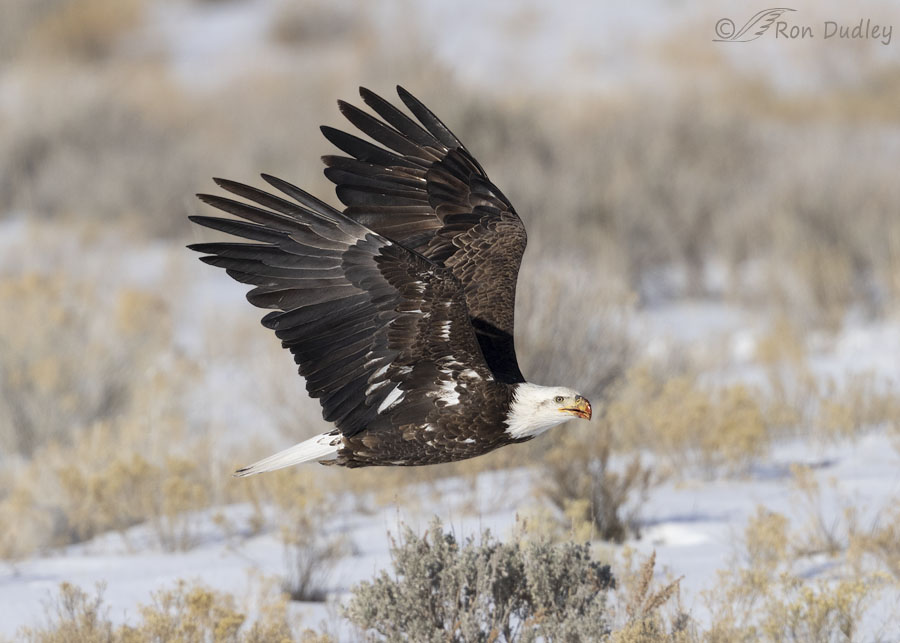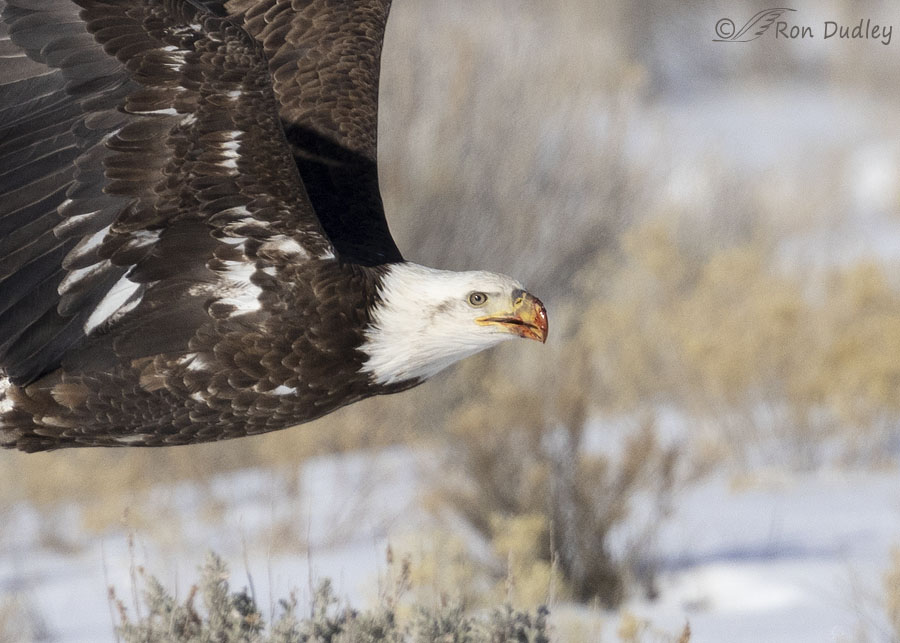Plus a highly unusual perspective on my shooting location.
Yesterday morning I found ravens, magpies and two Bald Eagles scavenging a carcass of some kind that I couldn’t see from the road because it was hidden in a shallow depression. Both eagles spooked as I drove closer but one of them circled around and came back very low to the ground prior to flying over the carcass again and eventually landing farther away.

1/5000, f/5.6, ISO 500, Canon R5, Canon EF500mm f/4L IS II USM + 1.4 tc, not baited, set up or called in
The nearly adult eagle’s low and slow approach to the carcass allowed me to get dozens of sharp flight shots as it skimmed over the sagebrush and other vegetation. Some of the magpies and ravens had small amounts of blood on their beaks but compared to the eagle they were clean and pristine.

Not only was the eagle’s beak bloody, it also had bits of flesh and gore stuck to the top of it (more easily seen in some of my other photos).
I haven’t yet had time or opportunity to review and cull yesterday’s photos, much less process those that I like, so this morning I’m only posting one of the eagle shots. I may be posting more of them in the future but I have other interesting photos from yesterday I’ll be posting too.
Ron
PS -My jaw doesn’t drop easily but this video of Northern Utah and Great Salt Lake taken by ISS (International Space Station) at 7:57 yesterday morning made it happen. When the video was taken by ISS, and when I was photographing this eagle, I was very near the remote shore of the lake in its northeast quadrant (the video orientation is skewed so true north is at upper left – more left than upper). If you squint really really hard, maybe you’ll be able to see me waving at you…
So if you’d like a window into my cold and snowy world from 248 miles above Great Salt Lake, here’s a link to the video. Be sure to watch it full screen, hopefully on a big screen rather than a mobile device. It… is… impressive.
Note: 248 miles is the average elevation of ISS. As you’d expect, it varies.


Always good to see evidence that a bird has eaten. The ISS video is, indeed, impressive (and I waved back!😉).
Marty, I’ve watched that video a half dozen times. Thanks for the wave.
Well, they do say “Bald is beautiful,” and even with the bloody beak, this eagle photo proves the point! GSL looks a whole lot different from way up there on ISS, hope all that snowpack becomes snowmelt that is allowed to restore its viability as a resource for all the wild creatures that depend on it.
Chris, yesterday I saw water in parts of the lake that have been dry for years. It may have just been local snow melt but it least it was wet.
Ron – Wonderful post today. The blood on the beak really points out how big those beaks are! It’s neat to see them in action on the various eagle nest cams. They look so big and bulky – like trying to pick up a quarter with a boxing glove – yet the parents manipulate them so delicately when feeding their chicks.
The peace and silence of the ISS video – beautiful. And fun to see the reply photos from the ground. Looks like you must have had quite a lovely morning.
And so glad you are making medical progress – just don’t get lazy and skimp on you at-home PT!
“Looks like you must have had quite a lovely morning.”
I did, Carolyn. It was a beautiful, clear morning, I had the entire area to myself except for a couple of ranchers I passed on the road and I got quite a few photos of birds doing interesting things. I was in my element.
What an impressive photo of this eagle. I am always amazed when a bird of prey doesn’t end up with blood, etc. all over its head and neck! I guess this eagle is not yet a parent. Thank you for all you do to capture amazing pictures to share with those of us without talent or equipment or impressive subjects! Loved the video from the space station.
Thanks, Melanie. Lots of raptors can get pretty bloody but it really stands out on adult Bald Eagles with their white head and yellow bill.
Must have been a sizable animal to attract all those birds to the feast. One wonders how they clean their beaks without a napkin, or at least a sleeve.
And how do the various species locate and identify a dead animal that doesn’t move. Smell, sight, other birds?
That looks like snow/ice on the ISS structure in the lower right. Impossible, right? What will that same scene look like 100–500 years hence?
“Must have been a sizable animal to attract all those birds to the feast”
My thought exactly, Lyle. I wondered if it might have been cow afterbirth.
super shots ron,thanks for sharing.
charlotte norton
Thanks, Charlotte.
Was that you in the space video in a pick-up that has a long tube sticking out the window?
Probably!
Focusing on the blood it is very easy to forget what a sharp and excellent photo of the eagle this is. The white and wing colors are super. Rarely ever have seen blood on one of our eagle’s beaks because I am always at our various lakes and they are always fishing. Much less blood than an animal carcass. Over the years we have had two of our eagles get sick from eating lead poisoned carcasses.
Remarkable from space video of your area. These are always fun and interesting to watch.
Will never forget that first full disk image of the earth taken by astronaut William Anders.
Thanks, Everett. Occasionally I used to see fish blood on eagle beaks at Farmington Bay WMA. These days, not so much.
Beautiful photo and subject. I also love the window seat on the plane. That video shows a wonderful site. How would it be to have that seat? Maybe in my next life.
Thanks, Betty.
Ever since you mentioned mobbing by crows I have noticed a lot of it. I recently saw crows chasing a bald eagle. They were flying only about 30 feet above a busy intersection. Traffic, fortunately had already stopped. Then, last week I saw crows mobbing a pair of mating hawks. So rude!
Robin, you often don’t have to watch crows for long before they mob something. They’re not particularly picky about it either.
Whenever I hear the crows mobbing, I start watching. Never know what they may be after. Usually hawks, owls and one time they chased a bobcat across my path.
Jo, same goes with other mobbing birds. It can be one way to locate raptors.
Great capture of the eagle, Ron – everything “gets the word” when there is a carcass available particularly this time of year. 🙂 The view from the ISS IS spectacular – things look SO different from above. Why I like flying with brother Mike even tho it’s a small plane. 😉
“everything “gets the word” when there is a carcass available”
Judy, the first time I passed this spot there were no birds on the carcass, if the carcass was even there. About 45 minutes later, on my way back, it was a flurry of avian scavenger activity from magpies, ravens and eagles.
I know magpies often have to wait for something to “open” the carcass spreading the “enticing” aromas such as a coyote or eagle and, until that happens, it may lay undisturbed.
So THAT’S what space stations are “for”…….capturing all that lacy, icy
beauty……and what a view it is ! Thanks……I’ve never understood folks
who reserve a window seat on the plane , and then spend the whole flight
sleeping , or with the window cover closed, or both, when I’m just dying to
see it ALL……the 2 day kink in your neck is worth it, if you can score a window
seat. Too bad that you hate flying– sometimes it’s worth the hassle, just
for the glory of all that “living” pattern below……
I’m like you, Kris. When I do have to fly, which I avoid whenever possible, I covet those window seats. And I’m sure I leave nose prints all over the window.
Since they took your picture, will you be sending them your picture of the eagle?
Ha, they have their own photos of the eagle, Brett. From 248 miles away, but still…
Sounds like a great opportunity and that is a great result with the eagles. And the view from ISS is quite magnificent! Beautiful area.
(I’m catching up, so…) it was good to read yesterday’s update on your medical recovery. I understand things like that are always too slow, but a positive trend is great news!
“a positive trend is great news”
It sure is, Duane. I just wish it didn’t have “downs” to go along with its ups. Those downs can be very discouraging – even though the overall trend is positive.
Great shot of the eagle. Looks like it was a sunny day. Good light. “He” looks a little put out by the interruption. Looking forward to seeing what else you got yesterday.
Watched that video. Wow! Looks like the view when flying over to Europe via the polar route. Even here in Los Angeles we have gotten the most snow in the local mountains since I can remember, and enough rain to float Noah’s Ark.
Michael, yesterday was one of the clearest days I’ve seen around here in years. The air was crisp, cold and clean, which I think contributes to the quality of the ISS video.
Wow, Ron! Even with all the gore, he is a handsome Eagle!! I can’t wait to see more of your captures!!
Thanks, Jo Ann. It may be a while but eventually I’ll probably post more of the eagle photos.